light RENAULT TWINGO 2009 2.G Chasiss ABS Workshop Manual
[x] Cancel search | Manufacturer: RENAULT, Model Year: 2009, Model line: TWINGO, Model: RENAULT TWINGO 2009 2.GPages: 76
Page 5 of 76
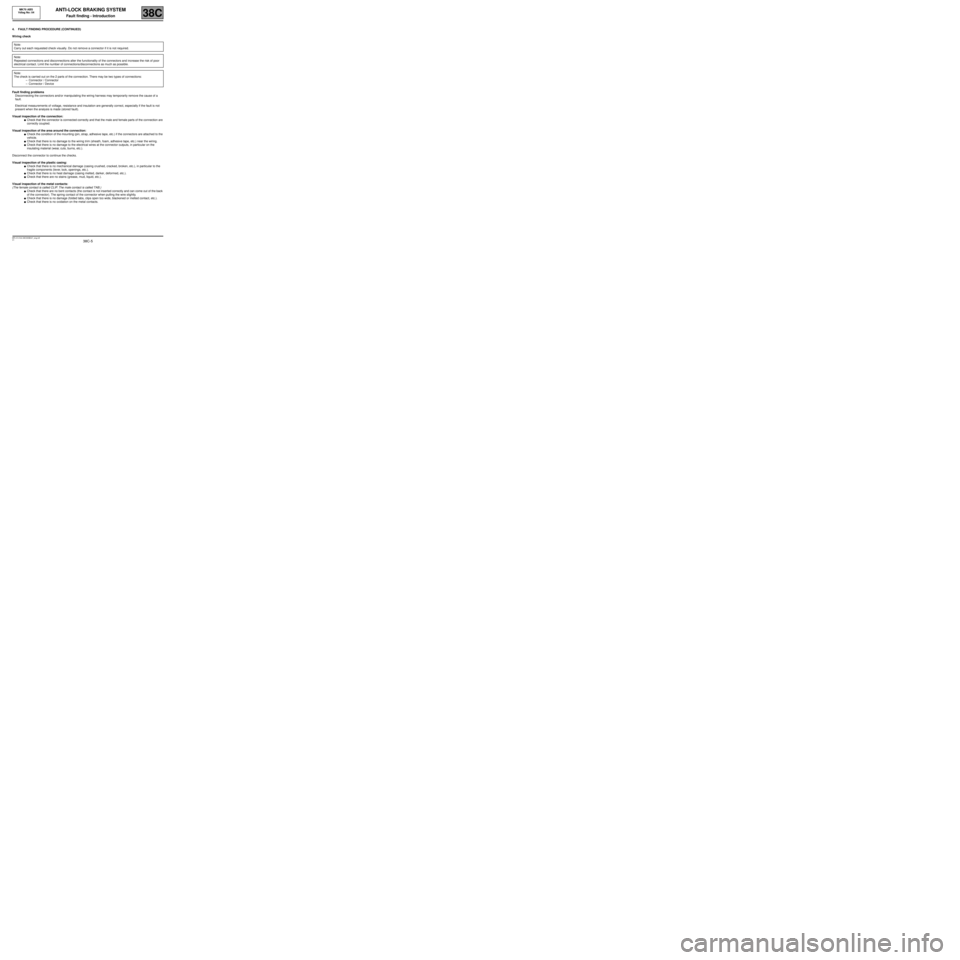
38C-5
MR-413-X44-38C000$047_eng.mif
V1
ANTI-LOCK BRAKING SYSTEM
Fault finding - Introduction
MK70 ABS
Vdiag No: 04
38C
4. FAULT FINDING PROCEDURE (CONTINUED)
Wiring check
Fault finding problems
Disconnecting the connectors and/or manipulating the wiring harness may temporarily remove the cause of a
fault.
Electrical measurements of voltage, resistance and insulation are generally correct, especially if the fault is not
present when the analysis is made (stored fault).
Visual inspection of the connection:
●Check that the connector is connected correctly and that the male and female parts of the connection are
correctly coupled.
Visual inspection of the area around the connection:
●Check the condition of the mounting (pin, strap, adhesive tape, etc.) if the connectors are attached to the
vehicle.
●Check that there is no damage to the wiring trim (sheath, foam, adhesive tape, etc.) near the wiring.
●Check that there is no damage to the electrical wires at the connector outputs, in particular on the
insulating material (wear, cuts, burns, etc.).
Disconnect the connector to continue the checks.
Visual inspection of the plastic casing:
●Check that there is no mechanical damage (casing crushed, cracked, broken, etc.), in particular to the
fragile components (lever, lock, openings, etc.).
●Check that there is no heat damage (casing melted, darker, deformed, etc.).
●Check that there are no stains (grease, mud, liquid, etc.).
Visual inspection of the metal contacts:
(The female contact is called CLIP. The male contact is called TAB.)
●Check that there are no bent contacts (the contact is not inserted correctly and can come out of the back
of the connector). The spring contact of the connector when pulling the wire slightly.
●Check that there is no damage (folded tabs, clips open too wide, blackened or melted contact, etc.).
●Check that there is no oxidation on the metal contacts. Note:
Carry out each requested check visually. Do not remove a connector if it is not required.
Note:
Repeated connections and disconnections alter the functionality of the connectors and increase the risk of poor
electrical contact. Limit the number of connections/disconnections as much as possible.
Note:
The check is carried out on the 2 parts of the connection. There may be two types of connections:
–Connector / Connector
–Connector / Device
Page 7 of 76
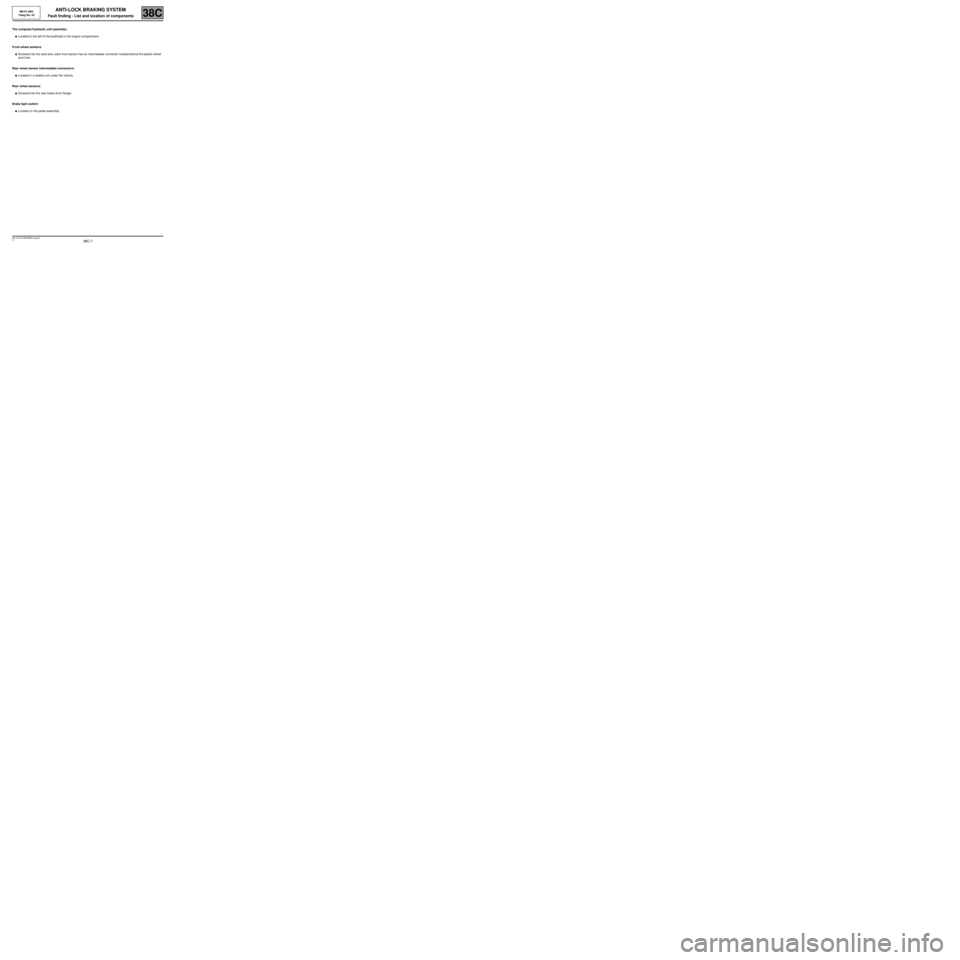
38C-7
MR-413-X44-38C000$094_eng.mif
V1
38C
ANTI-LOCK BRAKING SYSTEM
Fault finding - List and location of components
The computer/hydraulic unit assembly:
●Located to the left of the bulkhead in the engine compartment.
Front wheel sensors:
●Screwed into the stub-axle, each front sensor has an intermediate connector located behind the plastic wheel
arch liner.
Rear wheel sensor intermediate connectors:
●Located in a sealed unit under the vehicle.
Rear wheel sensors:
●Screwed into the rear brake drum flange.
Brake light switch:
●Located on the pedal assembly.
MK70 ABS
Vdiag No: 04
MR-413-X44-38C000$094_eng.mif
Page 8 of 76
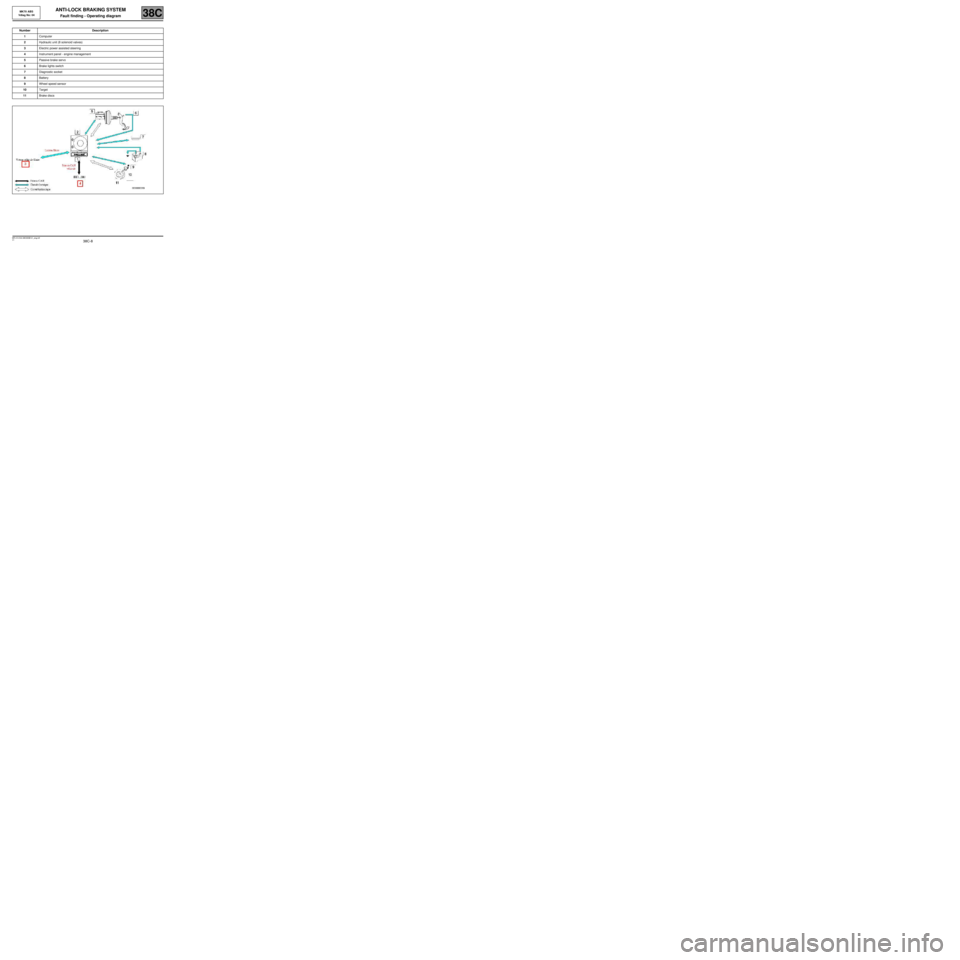
38C-8
MR-413-X44-38C000$141_eng.mif
V1
38C
ANTI-LOCK BRAKING SYSTEM
Fault finding - Operating diagram
Number Description
1Computer
2Hydraulic unit (8 solenoid valves)
3Electric power assisted steering
4Instrument panel - engine management
5Passive brake servo
6Brake lights switch
7Diagnostic socket
8Battery
9Wheel speed sensor
10Target
11Brake discs
MK70 ABS
Vdiag No: 04
MR-413-X44-38C000$141_eng.mif
Page 9 of 76
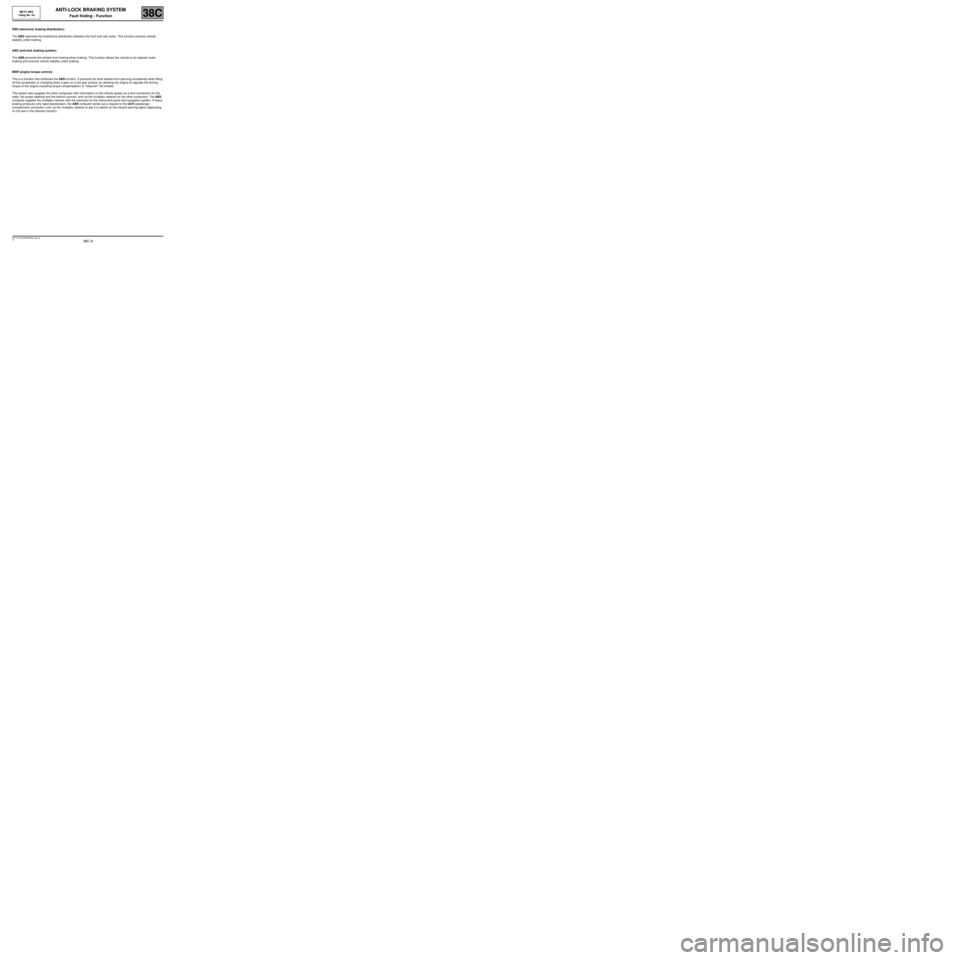
38C-9
MR-413-X44-38C000$188_eng.mif
V1
38C
ANTI-LOCK BRAKING SYSTEM
Fault finding - Function
EBD (electronic braking distribution):
The EBD optimises the brakeforce distribution between the front and rear axles. This function ensures vehicle
stability under braking.
ABS (anti-lock braking system):
The ABS prevents the wheels from locking when braking. This function allows the vehicle to be steered under
braking and ensures vehicle stability under braking.
MSR (engine torque control):
This is a function that enhances the ABS function. It prevents the drive wheels from spinning excessively when lifting
off the accelerator or changing down a gear on a low grip surface, by allowing the engine to regulate the driving
torque of the engine (resisting torque compensation) to "relaunch" the wheels.
The system also supplies the other computers with information on the vehicle speed via a wire connection for the
radio, the power steering and the electric sunroof, and via the multiplex network for the other computers. The ABS
computer supplies the multiplex network with the odometry for the instrument panel and navigation system. If heavy
braking produces very rapid deceleration, the ABS computer sends out a request to the UCH (passenger
compartment connection unit) via the multiplex network to ask it to switch on the hazard warning lights (depending
on the law in the relevant country).
MK70 ABS
Vdiag No: 04
MR-413-X44-38C000$188_eng.mif
Page 10 of 76
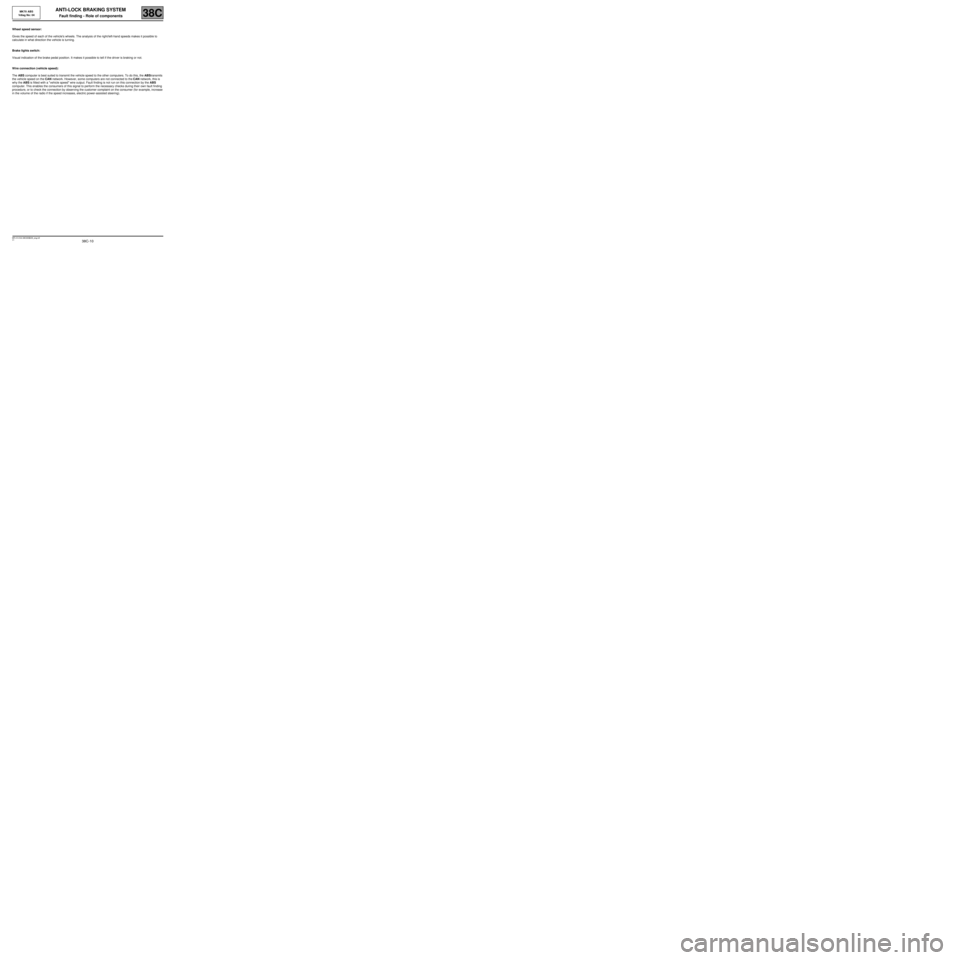
38C-10
MR-413-X44-38C000$235_eng.mif
V1
38C
ANTI-LOCK BRAKING SYSTEM
Fault finding - Role of components
Wheel speed sensor:
Gives the speed of each of the vehicle's wheels. The analysis of the right/left-hand speeds makes it possible to
calculate in what direction the vehicle is turning.
Brake lights switch:
Visual indication of the brake pedal position. It makes it possible to tell if the driver is braking or not.
Wire connection (vehicle speed):
The ABS computer is best suited to transmit the vehicle speed to the other computers. To do this, the ABS transmits
the vehicle speed on the CAN network. However, some computers are not connected to the CAN network, this is
why the ABS is fitted with a "vehicle speed" wire output. Fault finding is not run on this connection by the ABS
computer. This enables the consumers of this signal to perform the necessary checks during their own fault finding
procedure, or to check the connection by observing the customer complaint on the consumer (for example, increase
in the volume of the radio if the speed increases, electric power-assisted steering).
MK70 ABS
Vdiag No: 04
MR-413-X44-38C000$235_eng.mif
Page 11 of 76
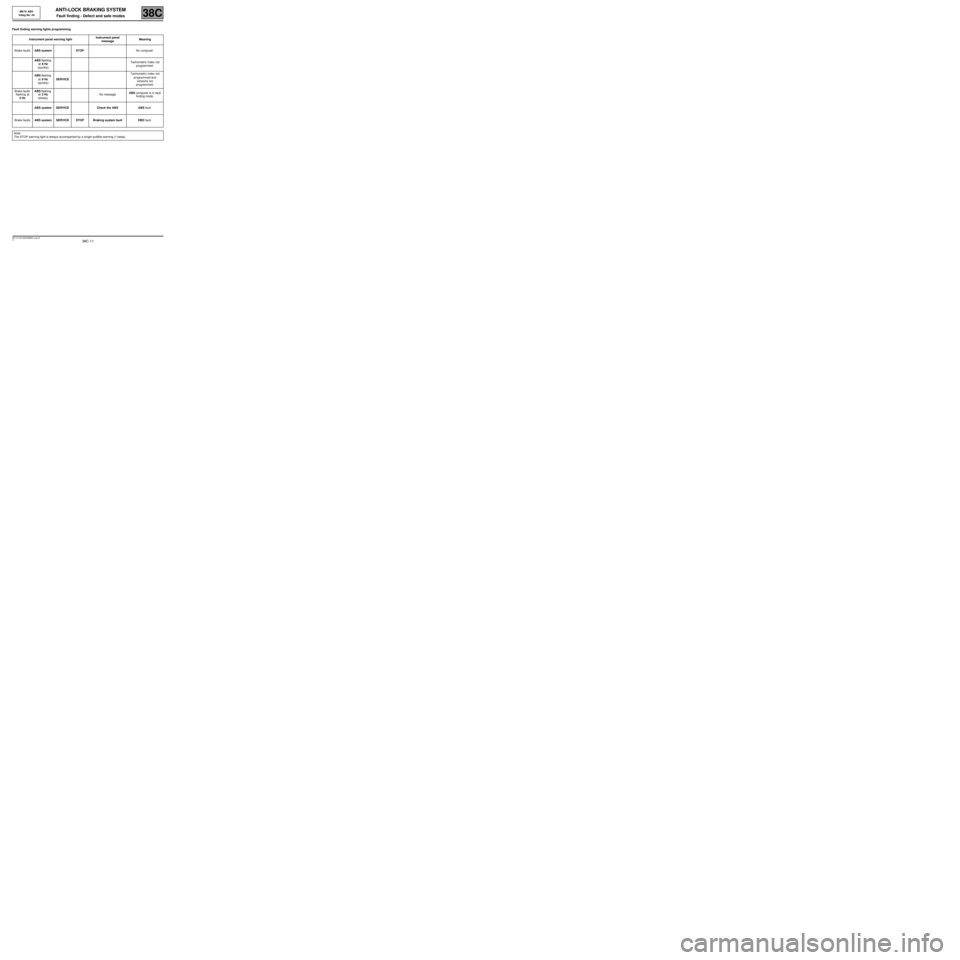
38C-11
MR-413-X44-38C000$282_eng.mif
V1
38C
ANTI-LOCK BRAKING SYSTEM
Fault finding - Defect and safe modes
Fault finding warning lights programming
Instrument panel warning lightInstrument panel
messageMeaning
Brake faultsABS system STOPNo computer.
ABS flashing
at 8 Hz
(quickly)Tachometric index not
programmed.
ABS flashing
at 8 Hz
(quickly)SERVICETachometric index not
programmed and
versions not
programmed.
Brake faults
flashing at
2 HzABS flashing
at 2 Hz
(slowly)No messageABS computer is in fault
finding mode.
ABS system SERVICE Check the ABS ABS fault.
Brake faultsABS system SERVICE STOP Braking system fault EBD fault.
Note:
The STOP warning light is always accompanied by a single audible warning (1 beep).
MK70 ABS
Vdiag No: 04
MR-413-X44-38C000$282_eng.mif
Page 14 of 76

38C-14
MR-413-X44-38C000$423_eng.mif
V1
38C
ANTI-LOCK BRAKING SYSTEM
Fault finding - Fault summary table
Tool fault Associated DTC Diagnostic tool title
DF00150 Short circuit Computer supply
DF0065015 Front left-hand wheel speed sensor circuit
DF0075035 Rear left-hand wheel speed sensor circuit
DF008501F Front left-hand wheel speed sensor signal
DF009503F Rear left-hand wheel speed sensor signal
DF01050D3 Pump motor circuit
DF01750C3 Computer
DF0205140 Tachometric index programming
DF0265005 Front right-hand wheel speed sensor circuit
DF0275025 Rear right-hand wheel speed sensor circuit
DF028500F Front right-hand wheel speed sensor signal
DF029502F Rear right-hand wheel speed sensor signal
DF0555143 Vehicle parameter programming
DF06650E2 No injection multiplex signal
DF0905041 Front right-hand wheel target
DF0915042 Front left-hand wheel target
DF0925043 Rear right-hand wheel target
DF0935044 Rear left-hand wheel target
DF0965148 Computer internal electronic irregularity
DF09850E4 No UCH multiplex signal
DF1195150 Gearbox type configuration
DF121D11D Torque requested not available
DF15250E6 Multiplex network
DF18850C6 Brake light switch circuit
DF219D132 ABS multiplex signal consistency
DF2295002 Front right-hand wheel speed
DF2305011 Front left-hand wheel speed
DF2315021 Rear right-hand wheel speed
DF2325031 Rear left-hand wheel speed
DF250D117 Engine speed multiplex signal
DF251D118 Effective average torque multiplex signal
DF252D119 Torque request multiplex feedback signal
DF253D120 Recalculated torque multiplex signal
DF254D12F Resisting torque multiplex signal
DF31150E3 No BVR multiplex signal
MK70 ABS
Vdiag No: 04
MR-413-X44-38C000$423_eng.mif
Page 33 of 76

38C-33
MR-413-X44-38C000$470_eng.mif
V1
ANTI-LOCK BRAKING SYSTEM
Fault finding - Interpretation of faults
MK70 ABS
Vdiag No: 04
38C
DF066
PRESENT
OR
STOREDINJECTION MULTIPLEX SIGNAL ABSENT
NOTESSpecial notes:
Even though it is stored in the computer, this fault does not cause the warning light to
come on or a fault message, because the ABS system is not faulty.
Perform fault finding on the injection system using the diagnostic tool.
Note:
The injection computer does not always store these transient faults as quickly as the
ABS computer.
If no fault is stored in the injection computer, start the engine; if there is no fault
present, contact the Techline. After solving the injection system problem, erase
the faults from the ABS computer memory.
Priority in the event of a number of faults:
Deal with fault DF152 Multiplex network first if it is present or stored.
Conditions for applying the fault finding procedure to stored faults:
The fault is declared present when the engine is started up.
Perform a multiplex network test and an injection check (see MR413 Fault finding, 13B, Diesel injection or 17B,
Petrol injection) using the diagnostic tool.
If the fault is still present, contact the Techline.
AFTER REPAIRClear the computer fault memory.
Carry out a road test followed by another check with the diagnostic tool.
ABS_V04_DF066
Page 39 of 76
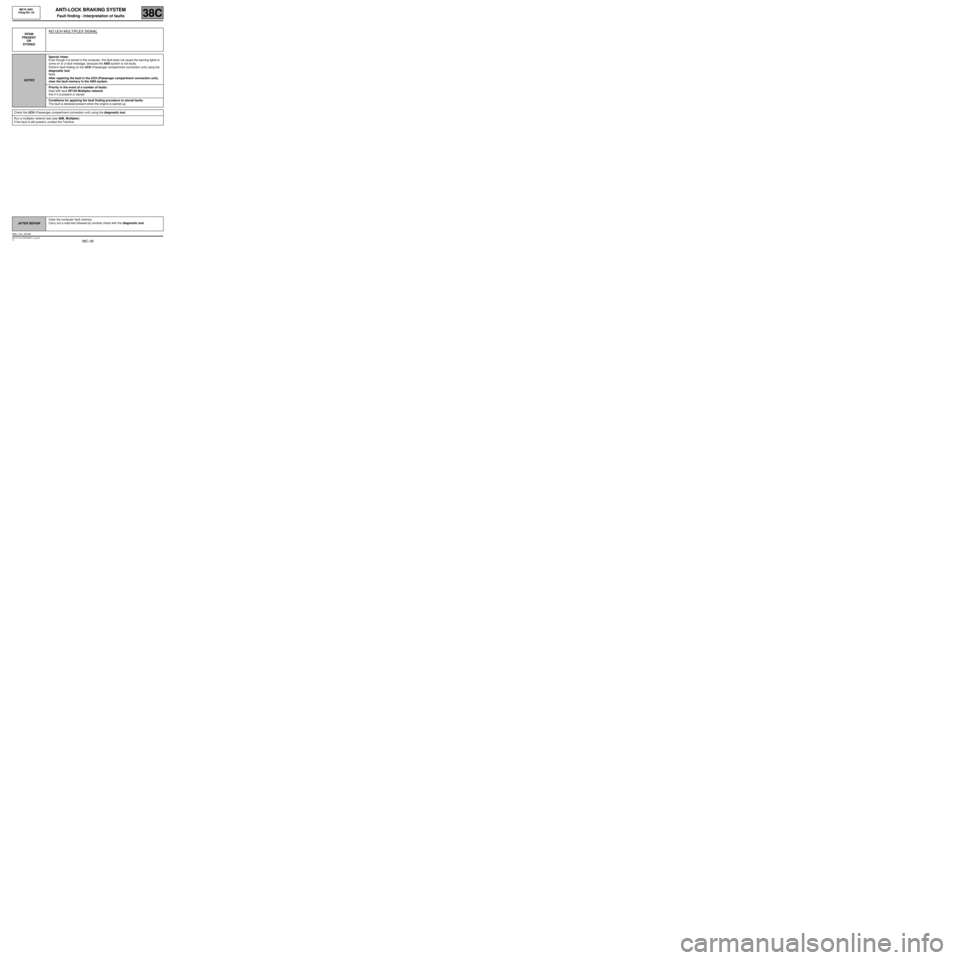
38C-39
MR-413-X44-38C000$517_eng.mif
V1
ANTI-LOCK BRAKING SYSTEM
Fault finding - Interpretation of faults
MK70 ABS
Vdiag No: 04
38C
DF098
PRESENT
OR
STOREDNO UCH MULTIPLEX SIGNAL
NOTESSpecial notes:
Even though it is stored in the computer, this fault does not cause the warning lights to
come on or a fault message, because the ABS system is not faulty.
Perform fault finding on the UCH (Passenger compartment connection unit) using the
diagnostic tool.
Note:
After repairing the fault in the UCH (Passenger compartment connection unit),
clear the fault memory in the ABS system.
Priority in the event of a number of faults:
Deal with fault DF152 Multiplex network
first if it is present or stored.
Conditions for applying the fault finding procedure to stored faults:
The fault is declared present when the engine is started up.
Check the UCH (Passenger compartment connection unit) using the diagnostic tool.
Run a multiplex network test (see 88B, Multiplex).
If the fault is still present, contact the Techline.
AFTER REPAIRClear the computer fault memory.
Carry out a road test followed by another check with the diagnostic tool.
ABS_V04_DF098
Page 43 of 76
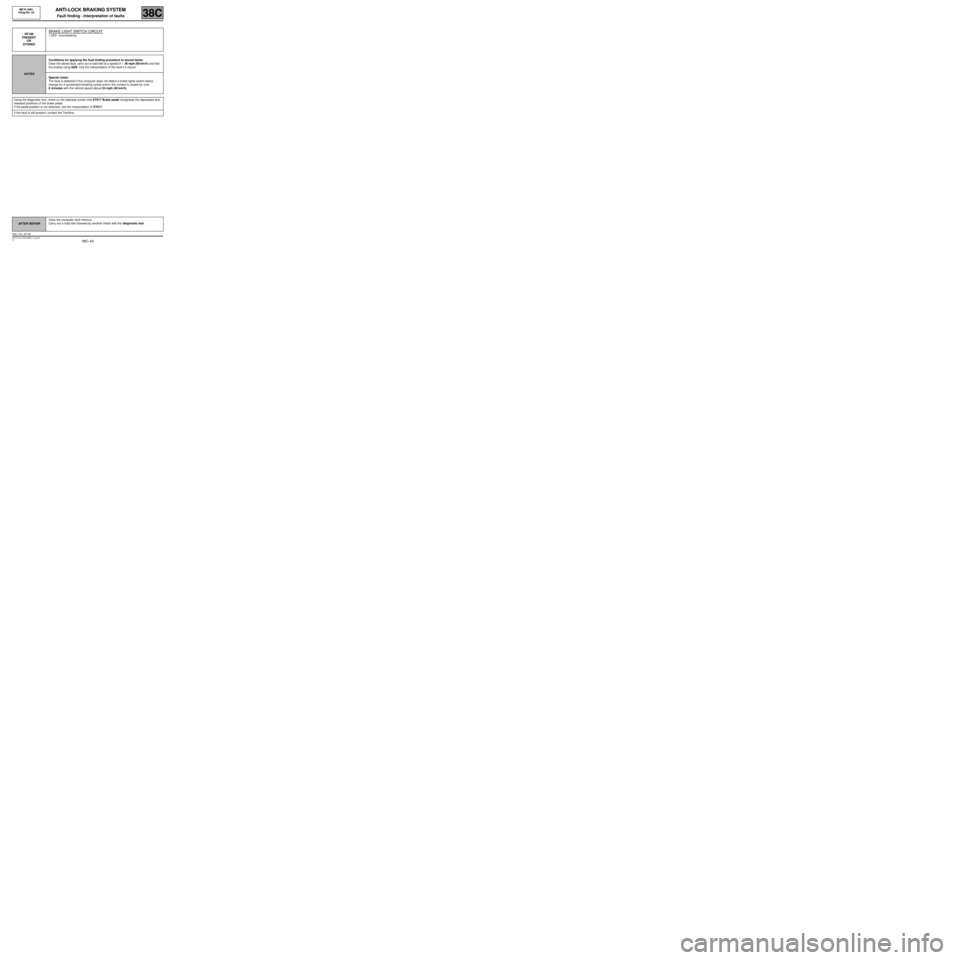
38C-43
MR-413-X44-38C000$517_eng.mif
V1
ANTI-LOCK BRAKING SYSTEM
Fault finding - Interpretation of faults
MK70 ABS
Vdiag No: 04
38C
DF188
PRESENT
OR
STOREDBRAKE LIGHT SWITCH CIRCUIT
1.DEF: Inconsistency
NOTESConditions for applying the fault finding procedure to stored faults:
Clear the stored fault, carry out a road test at a speed of > 36 mph (60 km/h) and test
the brakes using ABS. Use the interpretation of the fault if it recurs.
Special notes:
The fault is detected if the computer does not detect a brake lights switch status
change for 4 acceleration/braking cycles and/or the contact is closed for over
6 minutes with the vehicle speed above 24 mph (40 km/h).
Using the diagnostic tool, check on the statuses screen that ET017 Brake pedal recognises the depressed and
released positions of the brake pedal.
If the pedal position is not detected, use the interpretation of ET017.
If the fault is still present, contact the Techline.
AFTER REPAIRClear the computer fault memory.
Carry out a road test followed by another check with the diagnostic tool.
ABS_V04_DF188